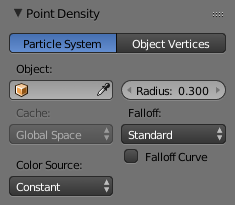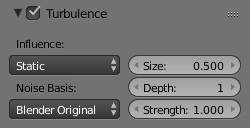Point Density Texture¶
Point density renders a given point cloud (object vertices or particle system) as a 3D volume, using a user-defined radius for the points. Internally, the system uses a BVH data structure for fast range lookups.
The rendered points are spherical by default, with various smooth falloff options, as well as simple Turbulence options for displacing the result with noise, adding fine detail. When using Point Density with a particle system, additional particle info such as particle velocity, age, and speed, can be visualized using a color/alpha ramp gradient.
Options¶

Point Density panel.
- Point Data
- Particle System
- Particle System, Generate point density from a particle system.
- Object Vertices
- Object Vertices, Generate point density from an object’s vertices.
- Object
- Object to tak epoint data from.
- Radius
Radius of the points.
- System
- Particle system to use.
- Falloff
- Standard
- Todo.
- Smooth
- Todo.
- Soft
- Todo.
- Softness
- Todo.
- Constant
- Todo. Density is constant within lookup radius.
- Root
- Todo.
- Particle Age
- Todo.
- Particle Velocity
- Todo.
- Velocity Scale
- Todo.
- Falloff Curve
- Use a custom falloff.
- Cache
Coordinate system to cache particles in.
- Global Space
- Todo.
- Emit Object Space
- Todo.
- Emit Object Location
- Todo.
- Color Source
Data to derive the color results from.
- Constant
- Constant color
- Particle Color Sources
- Particle Age
- Lifetime mapped as 0.0 - 1.0 intensity.
- Particle Speed
Particle speed (absolute magnitude of velocity) mapped as 0.0 - 1.0 intensity. An additional color ramp can be used to convert intensity to RGB colors.
- Scale
- Multiplier to bring particle speed within an acceptable range.
- Particle Velocity
XYZ velocity mapped to RGB colors.
- Scale
- Multiplier to bring particle speed within an acceptable range.
- Vertex Color Sources
- Vertex Color
Use a vertex color layer for coloring the point density texture.
Note
Vertex colors are defined per face corner. A single vertex can have as many different colors as faces it is part of. The actual color of the point density texture is averaged from all vertex corners.
- Vertex Weight
- Use a weights from a vertex group as intensity values. An additional color ramp can be used to convert intensity to RGB colors.
- Vertex Normals
- Use object-space vertex normals as RGB values.
Turbulence¶

Turbulence panel.
Adds directed noise to the density at render time.
- Influence
Method for driving added turbulent noise.
- Static
- Noise patterns will remain unchanged, faster and suitable for stills.
- Particle Velocity
- Turbulent noise driven by particle velocity.
- Particle Age
- Turbulent noise driven by the particle’s age between birth and death.
- Global Time
- Turbulent noise driven by the global current frame.
- Noise Basis
- See Here.
- Size
- Scale of the turbulent noise.
- Depth
- Level of detail in the added turbulent noise.
- Turbulence Strength
- Strength of the added turbulent noise.